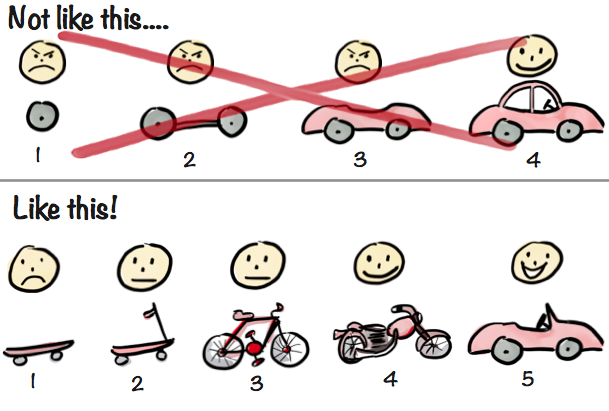Minimum Viable Progress
Dare to build products that dream bigger.

On Thinking Beyond Minimum Viable Progress
Dare to build products that dream bigger.
There’s a trendy image retweeting across Twitter. It’s bubbled into my feed one too many times so I’m fighting back against the truism it illustrates. Maybe you’ve seen it too:

Stating the obvious, no car inventor — from Henry Ford to Elon Musk — started by taking a skateboard to market. We didn’t get a man on the moon by teaching Neil Armstrong to ride a pogo stick and then later adding rocket boosters to get him into space. Big ideas, the stuff of real innovation that has the potential to change the world, can rarely grow on minimum viable shoulders. Big ideas need big runways and a lot of resolve from the people behind them.
But hell, there are even exceptions to that. So my second point is: be careful of the truism you preach… or retweet. If you’re a product manager, like me, realize there’s no one-size-fits-all process. Being nimble means a few things from a product perspective… like being efficient with time and resources; like being flexible about how your product evolves.
So now my core point: realize there is no golden path to product building.
A path to consider: work backwards. Who is your user? What is it that you want to provide for them? How can you get the simplest version of this product to them in the shortest amount of time that solves their need? How will you measure success? For some, these answers reveal the minimum viable product (“MVP”) and the runway needed to make it.
But there are more paths to consider if you have the gumption to aim for something beyond “viable.” Great things are born from patience, time and pressure. These sorts of endeavors are highly risky and not for the faint of product management heart. You don’t get to start out with many answers. In fact, it’s sort of the opposite: you must be infatuated with the questions you’re looking to solve and love this pursuit. It’s the glue that keeps the team on track when the going gets tough.
Maybe I’m being too harsh on the image from the Twittersphere. Maybe it’s simply trying to illustrate the first path I mentioned. But I worry we’re in an age where some have found easy spoils by pontificating oversimplified recipes for success. They usually argue for simplicity, listening to users and MVPs. That’s fine if you’re designing for today. Maybe today needs another Yo app and yet I could care less.
So please consider this a hat tip to all the product people out there who are sweating something more than minimum viable progress.



